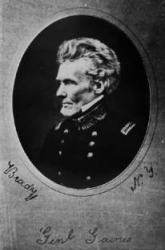
 |
|
|
||
|
Edmund Pendleton Gaines |
||||
|
Engagements: • Indian Wars (1775 - 1924) intermittent• War of 1812• Mexican-American Wars (1846 - 1848) |
||||
| Biography: | ||||
|
Edmund Pendleton Gaines Edmund Pendleton Gaines was born on 20 March 1777 in Culpeper County, VA, the son of James and Elizabeth Strother Gaines. Gaines was named after his great-uncle, Edmund Pendleton, who was the political leader of Virginia during the Revolution. Edmund's father, James, had been Captain of a Company in the American forces during the Revolutionary War and after the war his family moved to North Carolina where his father became a State Representative. He enlisted in the Army in 1799 and was a First Lieutenant by 1807. Mississippi Territory In the early 19th century, Gaines surveyed routes and boundaries in the Mississippi Territory including parts of the Natchez Trace. In 1807, Gaines was Commandant of Fort Stoddert. During this time, he arrested Aaron Burr and testified at his trial. Gaines also surveyed the route that would become the portion of the Gaines Trace from the Tennessee River to Cotton Gin Port, MS. He afterwards took a leave of absence from the Army to practice law. War of 1812 The War of 1812 brought Gaines back to the Army and he was appointed Major of the Eighth U.S. Infantry and, in July 1812, was made a Lieutenant Colonel in the Twenty-Fourth U.S. Infantry. In 1813, he was promoted to Colonel and Commanded the Twenty-Fifth Infantry with distinction at the Battle of Crysler's Farm. He became Adjutant General and was with General William Henry Harrison's Army at the Battle of the Thames. He was promoted to Brigadier General of Regulars on 9 March 1814 and Commanded the Post at Fort Erie after the U.S. capture. General Jacob Brown was wounded at the Battle of Lundy's Lane and when the U.S. Army of the Niagara returned to the Fort, command was passed to Gaines. At the Siege of Fort Erie, Gaines was in command on the fortifications on 15 August 1814, when a British assault was bloodily repulsed. For this victory - the First Battle of Fort Erie - Gaines was awarded the Thanks of Congress, an Act of Congress Gold Medal (outranking a Congressional Medal of Honor, according to the Smithsonian), and a brevet promotion to Major General. Gaines was seriously wounded by artillery fire and General Brown, having recovered, returned to command. Gaines' wound ended his active field career for the rest of the war, and he was given command of Military District Number 6. Indian Affairs At the end of the war, Gaines was sent as Commissioner to deal with the Creek Indians. The U.S. Commanding General, Jacob Brown, died in 1828; and Gaines was one of two ranking generals who could have been considered for the post. However, he and the other General, Winfield Scott, had both publicly quarreled with each other, and Alexander Macomb was promoted over both of them. He commanded the Western Military Department during the Black Hawk War. He was still in command of the Department during the Seminole Wars in which he personally led an expedition. At the Battle of Ouithlacoochie he was wounded in the mouth. 1n 1830, Gaines opposed President Andrew Jackson's policy of Indian removal. Southwest Frontier In 1836, Gaines was placed in command of the Southwest Military District. He was given instructions to fortify the border of the Louisiana Territory and Texas in the case that the Mexican Army might threaten U.S. territory. He was also given orders to post guards preventing any U.S. soldiers from crossing into Texas and fighting in the rebellion. He was in command of the Army's Western Division at the outbreak of the Mexican-American War. He was reprimanded by the U.S. government for overstepping his authority by calling up Louisiana volunteers for Zachary Taylor's Army. He nevertheless called up volunteers from other southwestern states and received a court-martial but was able to successfully defend himself. Later Life In the years during and following the Mexican-American War, Gaines was in command of a series of military districts. He was in command of the Western Division when he died at New Orleans, LA, on 6 June 1849. Honors A number of places in the U.S. have been named in his honor, including Gainesville in Florida, Texas, and Georgia; Gaines Township in Michigan; and Gainesboro in Tennessee. He was also the namesake of Gaines Streets in Tallahassee, FL; and Davenport, IA; and Fort Gaines, a historic fort on Dauphin Island, AL. Personal Brother of George Strother Gaines. Husband of Frances Toulmin, Barbara Blount, and Myra Clark. Death and Burial Major General Edmund Pendleton Gaines died on 6 June 1849 in New Orleans, LA. He is buried at the Church Street Graveyard in Mobile, AL. |
||||
| Honoree ID: 2530 | Created by: MHOH | |||
Ribbons
Medals
Badges
Honoree Photos
 |  |  |
 |  |
 |


